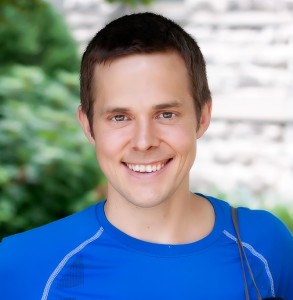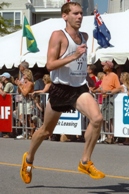Since 2010, I’ve been helping runners run faster. But a unique benefit of having a website like this is that I get to connect with elite runners, other coaches, Boston Qualifiers, and more experts in the running world.
And more importantly, I can bring them to you.
You’ve seen an interview with ultramarathoner Joel Runyon on how to set goals that scare you.
Or how to run with good form in a lengthy chat with coach Jeff Gaudette.
I’ve even interviewed pro Dathan Ritzenhein.
These are all experts in a specific aspect of running, whether it’s goal-setting, coaching, or performing. All of them can be instrumental in helping you accomplish your goals.
And today, I’m excited to highlight three more runners with unique advice on the art of racing. Specifically, how to strategically pace your race so you can run faster.
These strategies are excerpts from the book 13 Lucky Racing Tips for Your Next Personal Best: Pacing and Race Strategy from Elite Coaches, Boston Qualifiers, and All-Americans.
This book is free – you can download it here.
The Restraint Racing Method
For me, every race I run is a test of restraint. So many times when I was a new runner, I started too fast and crashed, 10 miles into a half marathon or 18 miles into a full. Even since I’ve found the discipline to pace myself properly, I still need to keep my head in check, because I believe that in an endurance event like a marathon or ultra, I’ll be relying on my mind to keep me going strong during the last quarter of the race.
It’s so easy in the moment to convince yourself that today is different, that there’s something special about how you’re feeling in this particular race, and you’ll be able to maintain a pace that’s way beyond your ability. This is adrenaline trying to fool you. Now, before I get to the starting line of a race, I have a pace in my head that I will not exceed, no matter what. Only once I get to mile 20 of a marathon will I allow myself to speed up if I still want to (note: this has never happened).
I also pay a lot of attention to the mental energy I’m expending, just as much as the physical. I avoid caffeine before the race, because although there’s a known endurance benefit, I know that it gets my mind racing as well. And when that happens, it’s always followed by a crash, just like you bonk when you put forth too much physical effort.
So for the first half of a marathon, I do everything in my power to relax — I try not to focus, I glance at my watch as little as possible, and I do what I can to enjoy the scenery and think about things other than running. I’ll check my form now and then and make sure I’m running efficiently, and often, I pay attention to my breathing. If it’s relaxed and my breaths are long, I know I’m not running too fast.

Essentially, I do whatever I can to forget that I’m racing. Too many times I’ve gotten myself all amped up at the beginning of a race, only to find that by mile 15, I’m mentally exhausted.
Matt Frazier is a vegan marathoner, ultrarunner, and author of No Meat Athlete living in Asheville, North Carolina. He writes the vegetarian running blog No Meat Athlete, where he offers a free, 10-part e-course on plant-based nutrition for endurance training.
Stick to the Plan!
When I ran my first marathon, I was told over and over again “not to go out too fast.” So I promised my running pal numerous times I wouldn’t run faster than an 8:30 pace for the first 10 miles — something that seemed completely feasible during my two-week taper period.
However, once I was out on the course, I quickly learned how hard it is to fight adrenaline and the roaring crowds (an 8:30 minute pace felt like I was walking) and had to fight every urge in order to keep my promise.
Negative splitting — running the second half of a race faster than the first half — is a common race tactic among marathoners. And after my first 26.2, going out slower and picking up the pace may very well lead to not only a strong finish, but an enjoyable run along the way.
In the moment, I worried whether running conservatively in the beginning would ruin my chance for hitting my goal-time. But I convinced myself that going out controlled and conserving energy would lead to finishing with strength and speed, which is exactly what happened. (I ended up reaching my finish goal and then some!)
In a race, it’s easy to go out too fast and end up paying for it later, especially in a marathon. At mile three, you may feel incredibly awesome and want to test your speed, push boundaries, and break world records. But don’t forget you have 23 more miles to go, and those faster miles will catch up with you.

So if you want to have an awesome race experience, go out slower than your goal pace and pick up the pace steadily throughout, up until the point when you’re using every ounce of energy for those final miles and leaving absolutely everything on the course.
Laura Schwecherl is the Outreach Director at Greatist, and writes about running, New York City, and traveling in between at Camping Out In America.
Let Jesus Take Over
Starting your race conservatively, being realistic, and planning for a negative split are all great strategies.
But sometimes, you have to go all in. There comes a race where every runner needs to take a risk and start fast. Very fast.
When I was in college, I used to joke with my teammates that whenever I ran a short race like the Mile, I would run the first half much faster than my average goal pace and then “let Jesus take over.”
Why would I start significantly faster than my PR pace and simply hope that I didn’t crash and burn? Simple: sometimes it’s the only way to find out what you’re made out of. Race breakthroughs don’t happen if you’re always conservative.
When you’re in really good shape then you can afford to take a big risk and start a race faster than you think you should. So if your PR in the 5k is 21:42 (or 7 minutes per mile) and you’ve had an amazing two months of training, it’s time to gamble.
For this hypothetical scenario, run the first two miles in 13:30 (or 6:45 per mile) and then hang on for dear life. If you’re successful, you could end up with a 46 second PR! That’s enormous in a short race like a 5k.
Now, the cautious among you might be asking, “But, won’t I slow down, feel terrible, and run slower than my PR?” Sure, that could happen. And it’s more probable than you having a breakthrough race.

But with no risk, there’s no reward. The next time you’re in very good shape, take a gamble and “let Jesus take over.”
Jason Fitzgerald is the founder of Strength Running, a USATF-certified coach, and author of 101 Simple Ways to be a Better Runner. He’s run 2:39:32 in the marathon and his coaching advice has been featured in Runner’s World, Health Magazine, Lifehacker, Active, Competitor, and the Huffington Post.
Get the Whole Book!
The full book features 10 more race strategies from a wide variety of runners. You’ll hear advice from:
- Jay Johnson (coach to 3 national champions on the road, track, and cross country)
- Mario Fraioli (Senior Editor at Competitor Magazine and a 2:28 marathoner)
- Susan Lacke (Ironman triathlete and columnist for Competitor and Triathlete)
- and a lot more…
Sign up here to get all 13 race strategies, for free.
After you read the book, leave a comment below: who would you love to hear from about their favorite racing strategy? I’ll try to make it happen!
